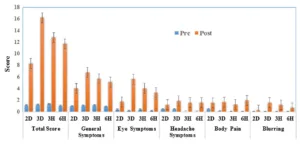A duo of researchers lead by Ph.D. student Mohammed Alhaag within the Industrial Engineering Department at the King Saud University (Riyadh, Kingdom of Saudi Arabia) have conducted a study to compare the extent of visual fatigue experienced when watching movies in 2D and 3D.
A recent publication on this topic by these researchers is entitled “Using electromyography responses to investigate the effects of the display type, viewing distance, and viewing time on visual fatigue.” The article was published in Displays, Volume 49, September 2017, Pages 51-58. A copy of the article is available for purchase here.
The causes of visual fatigue associated with watching 3D are well known and ultimately due to abnormal viewing conditions (think accommodation/convergence mismatch) or issues related to the viewing environment or to the display. Display-centric issues include undesired effects related to viewing angle, compromised image quality and flicker. More relevant to the study at hand, viewing time and viewing distance are also factors known to effect the extent that a user experiences visual fatigue.
Twenty male university students were used as test subjects in this study. Their mean age was 27.7 years and all had normal vision. 2D and 3D movies were presented on commercially available LG 3D Smart TVs that utilized passive, row interlaced technology. Participants that watched 3D movies wore passive glasses in which the two lenses contained orthogonal circular polarizers. Each participant came to the lab four times on different days for sessions lasting about two hours. The time between visits was at least 48 hours. This schedule allowed ample opportunity for any visual fatigue to completely dissipate between tests.
The participants were randomly assigned to one of four test conditions:
- Watch the four movies in 3D from a distance of 1.95 m (3D3H).
- Watch the four movies in 3D from a distance of 3.90 m (3D6H).
- Watch the four movies in 2D from a distance of 1.95 m (2D3H).
- Watch the four movies in 2D from a distance of 3.90 m (2D6H).
In this study, both objective and subjective response measurement methods were used to evaluate visual fatigue.
Objective Study
The objective part of the study used electromyography (EMG) to investigate the relationship between orbicularis oculi (OO) muscle activity and visual fatigue. The EMG signal is an electrical current produced by muscles as they contract and track neuromuscular activity. Variations in EMG activity during “consistent voluntary contractions are frequently used as indicators of muscle fatigue.” EMG recordings from the OO, a muscle in the face that closes the eyelids, are known to be a sensitive measure of discomfort resulting from glare.
Subjective Study
In the subjective portion of this study, the participants were asked to fill out a Visual Discomfort Questionnaire (VDQ) to rate their perceptions of visual fatigue. The VDQ included 41 questions that could be divided into five groups based on the following independent factors:
- General symptoms
- Eye symptoms
- Headache symptoms
- Body pain
- Blurred vision
The current study investigated the effects of display type (2D versus 3D), viewing distance (3H versus 6H) and viewing time on visual fatigue. The objectively measured property was the percentage of maximum EMG contraction (%MVC) of OO muscle activity. The subjectively measured property was the so-called total visual discomfort score. Data was collected both before participation in tests (Pre) and after testing (Post).
The top level results of the study showed that:
- Watching the 3D display clearly caused more visual discomfort than watching the 2D display regardless of the viewing distance. This discomfort manifested as eye symptoms, blurring and general symptoms.
- The viewing time and distance had significant effects on the %MVC and OO muscle activity with the details depending on the display type.
- The OO muscle activity of the participants watching the 3D display from a long distance (6H) did not change over the viewing time. This suggests that watching the 3D display was less stressful than watching the 2D display at long viewing distances.
- Watching the 3D display from a short viewing distance contributed to the eventual deterioration of the capability to accommodate and converge. This, in turn, likely caused development of greater visual fatigue watching the 3D display as compared to watching the 2D display from an equivalent short viewing distance.
- A wide field of view can cause increased cyber sickness.
These last two bullet points hang together in that the reason offered for increasing visual fatigue while viewing 3D display from short viewing distance is that doing so increases the field of view.
“Time was found to be the most significant contribution to visual fatigue compared to other factors (23.8%), followed by the time-display-distance interaction (9.5%), time-distance interaction (7.6%), distance-display interaction (4%) and distance (3.19%). “
The figure in the researcher’s article that best summarizes the results of the study is shown below.
Effect of display type and viewing distance on visual discomfort ratings while watching movies for 60 minutes.
The researchers acknowledge that some differences were found when comparing the main findings of their study with results reported in previously published studies. The main reasons for these differences are variations in experimental environments, measurement methods and the independent factors used in the studies. Apparently somewhat less well understood is that the current results included some discrepancies between the subjective measure of visual fatigue and the objective measurements. More fully understanding these results is proposed as the subject of future research. -Arthur Berman
King Saud University, Mohammed H. Alhaag, +966-5559034918, [email protected]

